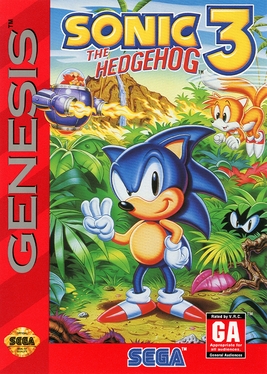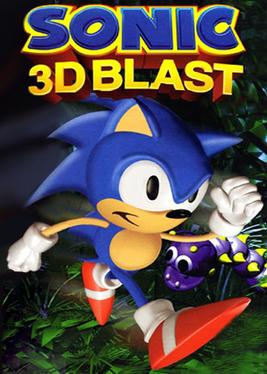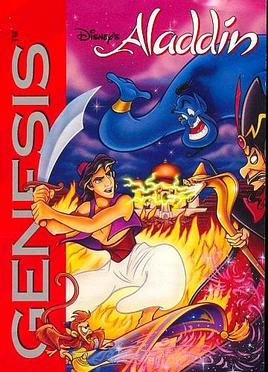
A platformer is a sub-genre of action video games in which the core objective is to move the player character between points in an environment. Platform games are characterized by levels with uneven terrain and suspended platforms of varying height that require jumping and climbing to traverse. Other acrobatic maneuvers may factor into the gameplay, such as swinging from vines or grappling hooks, jumping off walls, gliding through the air, or bouncing from springboards or trampolines.

Sonic the Hedgehog 3 is a 1994 platform game developed and published by Sega for the Genesis. Like previous Sonic games, players traverse side-scrolling levels while collecting rings and defeating enemies. They control Sonic and Tails, who attempt to retrieve the Chaos Emeralds to stop Doctor Robotnik from relaunching his space station, the Death Egg, after it crash-lands on a mysterious floating island. Sonic 3 introduces Knuckles the Echidna, the island guardian, who lays traps for Sonic and Tails.

The Master System is an 8-bit third-generation home video game console manufactured and developed by Sega. It was originally a remodeled export version of the Sega Mark III, the third iteration of the SG-1000 series of consoles, which was released in Japan in 1985 with graphical capabilities improved over its predecessors. The Master System launched in North America in 1986, followed by Europe in 1987, and then in Brazil and Korea in 1989. A Japanese version of the Master System was also launched in 1987, which features a few enhancements over the export models : a built-in FM audio chip, a rapid-fire switch, and a dedicated port for the 3D glasses. The Master System II, a cheaper model, was released in 1990 in North America, Australasia and Europe.

Sonic the Hedgehog is a 1991 platform game developed by Sonic Team and published by Sega for the Genesis/Mega Drive. It was released in North America on June 23 and in PAL regions and Japan the following month. Players control Sonic the Hedgehog, who can run at near supersonic speeds; Sonic sets out on a quest to defeat Dr. Robotnik, a scientist who has imprisoned animals in robots and seeks the powerful Chaos Emeralds. The gameplay involves collecting rings as a form of health, and a simple control scheme, with jumping and attacking controlled by a single button.

Sonic the Hedgehog is a 1991 platform game. It is a companion to the 16-bit Sega Genesis game Sonic the Hedgehog for the 8-bit Master System and Game Gear consoles. Ancient—a studio founded by composer Yuzo Koshiro for the project—developed the game and Sega published it to promote the handheld Game Gear. The 8-bit Sonic is a side-scrolling game similar in style to the 16-bit game, but reduced in complexity to fit the 8-bit systems.

Sonic Adventure 2 is a 2001 platform game developed by Sonic Team USA and published by Sega for the Dreamcast. It features two good-vs.-evil stories: Sonic the Hedgehog, Miles "Tails" Prower, and Knuckles the Echidna attempt to save the world, while Shadow the Hedgehog, Doctor Eggman and Rouge the Bat attempt to conquer it. The stories are divided into three gameplay styles: fast-paced platforming for Sonic and Shadow, multidirectional shooting for Tails and Eggman, and action-adventure exploration for Knuckles and Rouge.
In the history of video games, the fourth generation of video game consoles, more commonly referred to as the 16-bit era, began on October 30, 1987, with the Japanese release of NEC Home Electronics' PC Engine. Though NEC released the first console of this era, sales were mostly dominated by the rivalry between Sega and Nintendo across most markets: the Sega Mega Drive and the Super Nintendo Entertainment System. Cartridge-based handheld consoles became prominent during this time, such as the Nintendo Game Boy (1989), Atari Lynx (1989), Sega Game Gear (1990) and TurboExpress (1990).

Sonic 3D Blast, known in Europe and Japan as Sonic 3D: Flickies' Island, is a 1996 platform game in the Sonic the Hedgehog series for the Sega Genesis and Sega Saturn. As Sonic the Hedgehog, the player embarks on a journey to save the Flickies, birds enslaved by Doctor Robotnik. The player must guide Sonic through a series of themed levels to collect Flickies and defeat Robotnik. Though it retains game mechanics from prior Sonic games, Sonic 3D Blast is differentiated by its 2D isometric perspective, with pre-rendered 3D models converted into sprites.

Sonic & Knuckles is a 1994 platform game developed and published by Sega. Players control Sonic the Hedgehog or Knuckles the Echidna in their quests to save Angel Island; Sonic tries to stop Doctor Robotnik from re-launching his orbital weapon, the Death Egg, while Knuckles scuffles with Robotnik's minion, EggRobo. Like previous Sonic games, players traverse side-scrolling levels at high speeds while collecting rings and defeating enemies.

Sonic Advance, known as SonicN on the N-Gage, is a 2001 platform game developed by Dimps and published by Sega for the Game Boy Advance. It was the first Sonic the Hedgehog game released on a Nintendo console with Sonic Adventure 2: Battle on the GameCube, and was produced in commemoration of the series' tenth anniversary. The story follows Sonic, Tails, Knuckles, and Amy as they journey to stop Doctor Eggman from taking over the world. Controlling a character, players are tasked with completing each level, defeating Eggman and his robot army, and collecting the seven Chaos Emeralds.

Sonic the Hedgehog Spinball, also known as Sonic Spinball, is a 1993 pinball video game developed by Sega Technical Institute and published by Sega. It is a spinoff of the Sonic the Hedgehog series. Players control Sonic the Hedgehog, who must stop Doctor Robotnik from enslaving the population in a giant pinball-like mechanism. The game is set in a series of pinball machine-like environments with Sonic acting as the pinball.
1992 saw many sequels and prequels in video games, such as Dragon Quest V, Final Fantasy V, Sonic the Hedgehog 2, Street Fighter II: Champion Edition, Super Mario Land 2: 6 Golden Coins, and Super Mario Kart, along with new titles such as Art of Fighting, Lethal Enforcers, Mortal Kombat and Virtua Racing.

Sonic the Hedgehog 2 is a 1992 platform game developed by Aspect and published by Sega for the Master System and Game Gear. It is the sequel to the 8-bit Sonic the Hedgehog (1991) and follows Sonic as he attempts to get the Chaos Emeralds back to rescue his friend Miles "Tails" Prower from Dr. Robotnik. Like the first Sonic the Hedgehog, players run through levels at high speeds while collecting rings and defeating enemies. Although it shares the same title with Sonic the Hedgehog 2 for the Sega Genesis and their releases coincided, the games have little in common and share no levels.

The Sega Genesis, also known as the Mega Drive outside North America, is a 16-bit fourth generation home video game console developed and sold by Sega. It was Sega's third console and the successor to the Master System. Sega released it in 1988 in Japan as the Mega Drive, and in 1989 in North America as the Genesis. In 1990, it was distributed as the Mega Drive by Virgin Mastertronic in Europe, Ozisoft in Australasia, and Tectoy in Brazil. In South Korea, it was distributed by Samsung Electronics as the Super Gam*Boy and later the Super Aladdin Boy.

Sonic the Hedgehog is a video game series and media franchise created by the Japanese developers Yuji Naka, Naoto Ohshima, and Hirokazu Yasuhara for Sega. The franchise follows Sonic, an anthropomorphic blue hedgehog who battles the evil Doctor Eggman, a mad scientist. The main Sonic the Hedgehog games are platformers mostly developed by Sonic Team; other games, developed by various studios, include spin-offs in the racing, fighting, party and sports genres. The franchise also incorporates printed media, animations, feature films, and merchandise.

Sonic the Hedgehog 2 is a 1992 platform game developed by Sega Technical Institute (STI) for the Sega Genesis. Players control Sonic as he attempts to stop Doctor Robotnik from stealing the Chaos Emeralds to power his space station. Like the first Sonic the Hedgehog (1991), players traverse side-scrolling levels at high speeds while collecting rings, defeating enemies, and fighting bosses. Sonic 2 introduces Sonic's sidekick Miles "Tails" Prower and features faster gameplay, larger levels, a multiplayer mode, and special stages featuring pre-rendered 3D graphics.

Mario & Sonic at the Olympic Games is a 2007 crossover sports and party game developed by the Sega Sports R&D Department. It is the first installment on the Mario & Sonic series. It was published by Nintendo in Japan and by Sega in other regions, and released on the Wii in November 2007 and the Nintendo DS handheld in January 2008. The first official video game of the 2008 Summer Olympic Games, it is licensed by the International Olympic Committee (IOC) through exclusive licensee International Sports Multimedia (ISM), and is the first official crossover game to feature characters from both the Mario and Sonic the Hedgehog series.
The 1990s was the third decade in the industry's history. It was a decade of marked innovation in video gaming. It was a decade of transition from sprite-based graphics to full-fledged 3D graphics and it gave rise to several genres of video games including, but not limited to, the first-person shooter, real-time strategy, survival horror, and MMO. Arcade games, although still very popular in the early 1990s, began to decline as home consoles became more common. The fourth and fifth generation of video game consoles went on sale, including the Sega Genesis, Super Nintendo, Sega Saturn, PlayStation, Nintendo 64, and Game Boy Color. Notable games released in the 1990s included Super Mario World, Sonic the Hedgehog, Street Fighter II, Mortal Kombat, Killer Instinct, Tekken,Doom, Wolfenstein 3D, Quake, Duke Nukem 3D, Final Fantasy VII, Unreal Tournament, Star Fox, Half-Life, Grand Theft Auto, Super Mario 64, Pokémon Red and Blue, NBA Jam,Daytona USA, GoldenEye 007, System Shock 2, Civilization,Ridge Racer, Sonic Adventure, Gran Turismo, Super Mario Kart, Pokémon Gold and Silver,Castlevania: Symphony of the Night, Super Metroid, Silent Hill, The Legend of Zelda: Ocarina of Time, Crash Bandicoot, Spyro The Dragon, Fallout, Metal Gear Solid, Diablo, Virtua Fighter, Tomb Raider,Sega Rally Championship, Wing Commander,Super Smash Bros, Secret of Mana,Thief: The Dark Project, Age of Empires, Nights into Dreams, Panzer Dragoon, Gunstar Heroes, EverQuest, Chrono Trigger, Battletoads, Worms, Micro Machines, Streets of Rage 2,Baldur's Gate,Donkey Kong Country, Wipeout, The Legend of Zelda: A Link to the Past,Lemmings, EarthBound, StarCraft, Banjo-Kazooie, PaRappa the Rapper, Resident Evil, Tony Hawk's Pro Skater, Soulcalibur, Command & Conquer, and Dance Dance Revolution.

Disney's Aladdin is a platform game based on the 1992 film of the same name developed by Virgin Games USA. The game was released by Sega for the Sega Genesis on November 11, 1993 as one of several games based on the film, including another game that was released in the same month by Capcom for the Super NES.
















